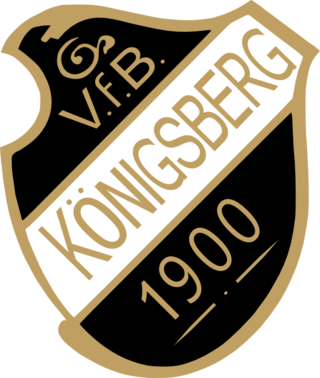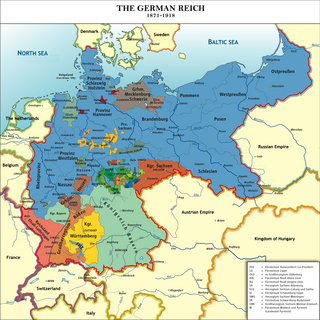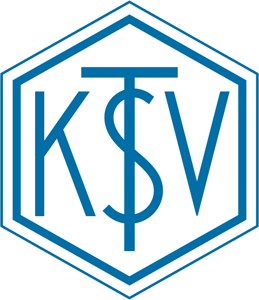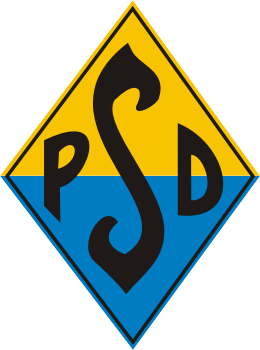
VfB Königsberg was a German association football club from the city of Königsberg, East Prussia. The team played its home games at the Sportplatz des Vereins für Bewegungs Spiele near the Maraunenhof Stadtgärtnerei, aside from 1940 to 1941 when they played at the Sportplatz am Friedländer Tor between Haberberg and Rosenau.
Preußen Danzig was a German association football club from the city of Danzig, West Prussia.

The Gauliga Ostpreußen was the highest football league in the Prussian province of East Prussia and the Free City of Danzig from 1933 to 1945. Shortly after the formation of the league, the Nazis reorganised the administrative regions in Germany, and the GauEast Prussia the Prussian province. Danzig however did not become part of this Gau, being integrated in the Gau Danzig-West Prussia in 1939 instead.

The Gauliga Danzig-Westpreußen was the highest football league in the former Reichsgau Danzig-West Prussia, a Nazi administrative unit established partly from German and partly from annexed territory.

Yorck Boyen Insterburg was a German association football club from the city of Insterburg, East Prussia.

SV Prussia-Samland Königsberg was a German association football club from the city of Königsberg, East Prussia.

SV Hindenburg Allenstein was a German football club from the city of Allenstein, East Prussia.

Stettiner SC was a German association football club from the city of Stettin, Pomerania.

Viktoria Stolp was a German association football club formed in 1909, from the city of Stolp, Pomerania which was at the time part of Germany and is today Słupsk, Poland.

BuEV Danzig was a German association football club formed in 1903, from the city of Danzig, West Prussia.
KS Gedania Danzig was an ethnically-Polish association football club that was part of German football competition in the inter-war period. It was formed in 1922 in what was at the time the Free City of Danzig. Banned by the Nazis in 1939, the club re-emerged following the end of World War II and is active today as Gedania 1922 Gdańsk.

Viktoria Allenstein was a German football club from what was the city of Allenstein, East Prussia in Germany and is today Olsztyn, Poland. The club was established in 1916 and played as a lower tier local side making only a single season appearance in the top flight regional Baltenverband in 1925–26.

The Baltic football championship was the highest association football competition in the Prussian provinces of East Prussia, Pomerania and West Prussia. The competition was disbanded in 1933.

SV Concordia Königsberg was a German association football club from the city of Königsberg, East Prussia.

Königsberger STV was a German association football club from the city of Königsberg, East Prussia.
Reichsbahn Königsberg was a German association football club from the city of Königsberg, East Prussia.
Luftwaffensportverein Danzig was a short-lived German association football club from the city of Danzig, West Prussia. LSV was an air force (Luftwaffe) sports club that was active from 1941–44 and was made up primarily of flak soldiers. During World War II it was common in Germany for military sides to take part in domestic competition. The most successful of these clubs was LSV Hamburg which appeared in the final of the Tschammerpokal, predecessor of today's German Cup, in 1943 and in the national championship final in 1944.

SG OrPo Danzig was a German association football club from the city of Danzig, West Prussia. It was established in 1920 as Sportverein Schutzpolizei Danzig as the sports club of the city's police force. Through the 1920s the club made regular appearances in the playoff rounds of the regional Baltenverband, but did not enjoy any success there. In 1934, SV became part of the Gauliga Ostpreussen and from 1935 to 1938 played within the Gauliga Danzig which was a division of the Ostpreussen league. The team was renamed Polizei SV Danzig in 1939 and took part that year in the opening round of the Tschammerpokal, predecessor to the current-day DFB-Pokal, where they were put out 2–3 by Viktoria Stolp. The team was renamed again in 1941, becoming Sportgemeinschaft der Ordnungspolizei Danzig in 1941, and from 1940 to 1943, was part of the Gauliga Danzig-Westpreußen.

Ostmark Danzig was a German association football club from the city of Danzig, West Prussia. Established at 1. September 1909, the club was notable only for its advance to the regional first division Baltenverband final in 1910–11. After receiving a quarterfinal bye, the team beat SV Marienwerder before losing the championship match 4–2 to Lituania Tilsit. The team disappeared following World War II when the city became part of Poland.

Post SG Danzig was a German association football club from the city of Danzig, West Prussia. It was the sports club of the city's postal workers and used the colours blue and yellow traditionally associated with the post office. In the early 1940s, the team was part of the Gauliga Danzig-Westpreußen, then one of the Germany's regional first division circuits, where they earned only lower table finishes. SG was active until September 1945 and disappeared following World War II when the city became part of Poland.















